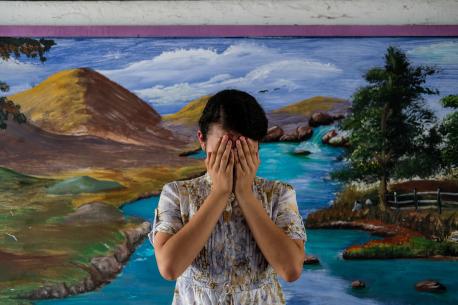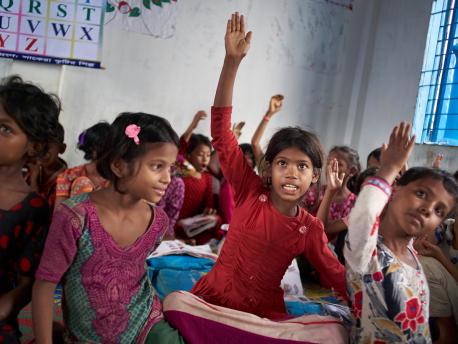
End Stigma, End Trafficking
Stigma may serve as both a result of, and a catalyst for, child trafficking.
Stigma is a process that attempts to discredit or disgrace a person or group based upon an identity or circumstance. It can lead to many consequences, including isolation and violence, by framing an individual as outside of or counter to a social norm. Though the stigmatization of trafficking survivors often goes unaddressed, its negative impacts can be devastating nevertheless. In many cultures, association with the sex industry—whether by force or choice—is highly stigmatized. Additionally, where support services for those who have experienced gender-based violence, domestic violence, or exploitation may exist, they may not be tailored towards the needs of trafficking survivors. These realities may further isolate survivors, prevent them from receiving the vital resources and support that they need, and may even leave them open to further abuse. Stigmatization may not only occur after a person has been trafficked, though; in fact, it may even lead to trafficking in the first place.
UNICEF and the International Organization on Migration (IOM) recently conducted research on the exploitation and trafficking of children traveling from Africa and the Middle East to Europe. Among these children on the move, children traveling from Sub-Saharan African were four times more likely to experience trafficking than their peers traveling along the same route. What separated these children from their peers? One major thing: the color of their skin.
Stigmatization and discrimination based on race, gender, class, or other identities is a major issue that can make children vulnerable to trafficking in a number of ways. Namely, it deprives young people of opportunities by restricting access to resources and safe employment. It also socially isolates them by creating a narrative that they are unwelcome and 'the other.' Traffickers can easily identify these at-risk youth and limited employment options make children further vulnerable to exploitation.
Harmful gender norms in particular make countless girls susceptible to trafficking. According to the International Labour Organization, approximately 70% of those who are subjected to modern slavery, which includes trafficking and forced marriage, are women and girls. The gendered nature of this phenomenon is no coincidence. Whether these norms exclude girls from educational settings, assume that women belong in the home or specific types of low-paying labor, or frame women as commodities rather than human beings, stereotypes and discriminatory practices continue to place girls at greater risk of experiencing trafficking worldwide. When combined, harmful social norms reinforce barriers that compromise girls' futures by excluding them from safe and legal work or perpetuating a notion that early marriage is a girls' only option for protection and social advancement.
This is why working with stakeholders at all levels is critical in order to build societies in which trafficking is not able to thrive in the first place. Community members in Côte d'Ivoire, for example, took matters into their own hands to educate local cocoa farmers about the importance of placing children—including girls—in school, rather than having them work on farms. In Afghanistan, local religious leaders work on the ground to convince families that daughters should not be married before the age of 18. All of these efforts—in concert with other systems-based approaches—are crucial pieces of the puzzle for creating a future where no child has to experience violence, abuse, or exploitation.
Take Action
Wondering what you can do to combat stigma? Here are some ideas to get you started:
- Analyze the harmful social norms in the world around you. Is the word 'pimp' used to refer to someone as cool rather than a child trafficker? Does the media you consume (e.g. music, television, advertising) portray women as objects rather than people? Brainstorm ways that you can challenge and question that behavior then put those practices into action.
- Check out anti-trafficking laws, trainings, and resources in your area. See some areas for improvement? Voice your concerns with your local representative and community leaders.
- Did you know that you can make your school, university, congregation, or town Fair Trade certified? Visit Fair Trade Campaigns to get started.
Join UNICEF USA in raising awareness of child trafficking this January!
You can do this by hosting your own End Trafficking event or partaking in our activations:
- Want to learn more about how demand plays a role in perpetuating trafficking? Our blog post (releasing on January 29th) is just for you!
- Tune into the Ending Human Trafficking Locally and Globally podcast on January 11th to learn about how students can get engaged to end trafficking.
- Tell your representatives that you support the passage of the Stop Enabling Sex Traffickers Act. (Check out our blog post on January 22nd to learn more!)
- Donate to support the End Trafficking Project at UNICEF USA!
- Activate for National Freedom Day on February 1st. For sample posts, visit the UNICEF USA Social Media Press Kit.
HOW TO HELP
There are many ways to make a difference
War, famine, poverty, natural disasters — threats to the world's children keep coming. But UNICEF won't stop working to keep children healthy and safe.
UNICEF works in over 190 countries and territories — more places than any other children's organization. UNICEF has the world's largest humanitarian warehouse and, when disaster strikes, can get supplies almost anywhere within 72 hours. Constantly innovating, always advocating for a better world for children, UNICEF works to ensure that every child can grow up healthy, educated, protected and respected.
Would you like to help give all children the opportunity to reach their full potential? There are many ways to get involved.





